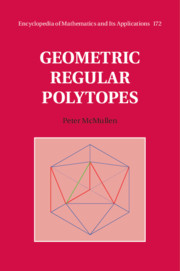Book contents
- Frontmatter
- Contents
- Foreword
- I Regular Polytopes
- 1 Euclidean Space
- 2 Abstract Regular Polytopes
- 3 Realizations of Symmetric Sets
- 4 Realizations of Polytopes
- 5 Operations and Constructions
- 6 Rigidity
- II Polytopes of Full Rank
- III Polytopes of Nearly Full Rank
- IV Miscellaneous Polytopes
- Afterword
- Bibliography
- Notation Index
- Author Index
- Subject Index
4 - Realizations of Polytopes
from I - Regular Polytopes
Published online by Cambridge University Press: 30 January 2020
- Frontmatter
- Contents
- Foreword
- I Regular Polytopes
- 1 Euclidean Space
- 2 Abstract Regular Polytopes
- 3 Realizations of Symmetric Sets
- 4 Realizations of Polytopes
- 5 Operations and Constructions
- 6 Rigidity
- II Polytopes of Full Rank
- III Polytopes of Nearly Full Rank
- IV Miscellaneous Polytopes
- Afterword
- Bibliography
- Notation Index
- Author Index
- Subject Index
Summary
Building on the previous chapter, this one moves on to the special case of polytopes. Wythoff’s construction is the basic way to obtain a polytope from a representation of an automorphism group, and leads to geometric analogues of some of the core operations on polytopes. Various connexions between rank and dimension of faithful realizations are then considered, in particular the concepts of full and nearly full rank. The important mirror vector lists the dimensions of the reflexion mirrors of a realization. Realizations that are degenerate in some respect also play a part; these are looked at next. Induced cosine vectors come from cuts such as vertex-figures and facets of polytopes; in a number of ways these provide additional tools for determining realization domains. A brief account of the alternating product of polytopes is then given, although these are rarely used. The theory of realizations of regular apeirotopes (infinite polytopes) is somewhat different; it is sketched here. For the most part, descriptions of realization spaces of particular polytopes are postponed until the polytopes themselves have been introduced; however, several basic examples are given including polygons, which are needed to formulate the notion of rigidity in Chapter 6.
Keywords
- Type
- Chapter
- Information
- Geometric Regular Polytopes , pp. 139 - 168Publisher: Cambridge University PressPrint publication year: 2020

